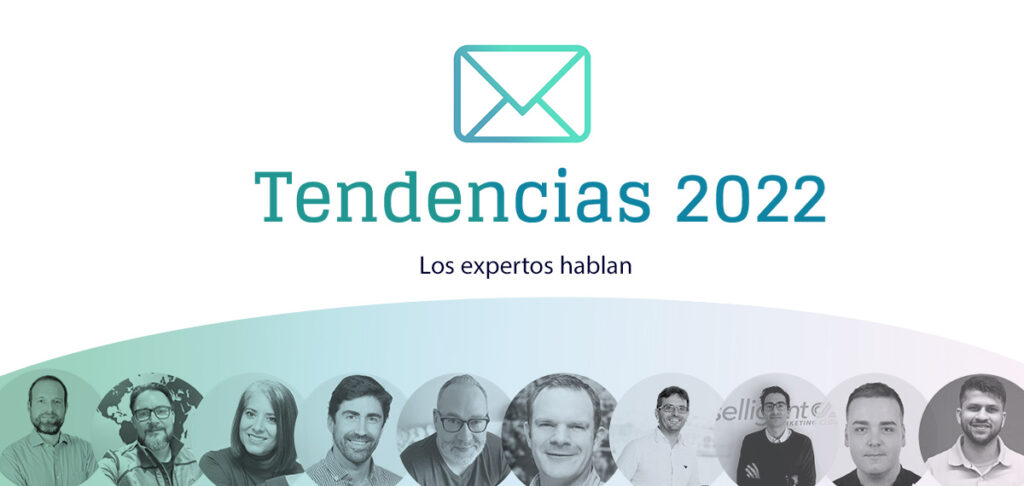Email Marketing Trends 2022: The Experts Speak Out


As we do every year, Digital Response would like to reflect on the key aspects that will dominate email marketing in the year ahead.
This time, we are also doing so with the participation of very prominent professionals who have wanted to share their points of view.

In 2021, we have seen how the momentum of the Covid-19 crisis in 2020 has been maintained in the digitisation of companies.
Companies continue to embrace online marketing and sales strategies, looking for alternatives to traditional channels. And without a doubt, one of the key channels is still email.
The trends that in our view will be consolidated in 2022 are as follows:
Unified management of "owned channels".
We are seeing how CRM teams are taking over all communications to own databases within so-called "owned channels". This includes both email marketing campaigns and, increasingly, the sending communications to mobile applications (push notifications, in app messages and message centre). As brands have success stories using these types of communications, the next natural step will be to integrate them into more complex programmes that also incorporate email. In fact, brands that tend to lead the way in the adoption of new marketing technologies are already implementing multi-channel programmes in which users can receive push notifications and/or emails based on the stage they are at in a given journey. In 2022 we will see multichannel campaigns gaining prominence.
Agile systems for the management of owned channels will be adopted.
Related to the previous point, we will see how marketing operations in owned channels are equipped with agile management systems. By marketing operations, we mean the set of tasks required to turn a plan, strategy or initiative into a perfectly executed campaign/journey (on time and error-free). Marketing operations are responsible for creating audiences, sending tests, validating links, including tracking codes and other tags, converting layouts into HTML pieces, writing query codes so that personalisation rules and dynamic content work correctly, etc. An increase in the complexity of marketing operations will lead to the adoption of agile management systems that reduce production times, avoid errors and increase team productivity.

CEO and Founder - Digital Response

2022 is going to be a curious year for email marketers, because the rules of the game are changing fast. On the one hand, the privacy is becoming more and more relevant, and examples such as Apple's "Do not track", or privacy protection in Apple Mail, are a clear example. A user can easily choose not to send information to the brand that sent the email, and the brand cannot know whether the user has opened the email or not. So the statistics of the Open ratewhich were already historically unreliable, are now even less so.
On the other hand, the personalisation and even hyper-personalisation, will still be in the spotlight in 2022. Brands that have not yet jumped on this bandwagon should do so as soon as possible, to ensure that their emails have a chance of being opened. Inboxes are becoming increasingly crowded, and the email we send needs to be relevant to our subscriber.
In order to be more effective, in turn, the interactive content within emails will save clicks and therefore allow us to be more effective. The possibility of displaying a form directly in an email, without the user having to go to the landing page, opens up a world of possibilities. I look forward to seeing how these practices become more popular.

Salesforce Marketing Champion - Cloud Coachers

The steady growth of the email marketing industry means that 2022 arrives with an air of great excitement. We are entering a new era of big data where traditional email marketing platforms are no longer able to cope with the real-time nature of data transfer that makes the customer experience stand out from the rest. When it comes to customer experience, integration and orchestration are the winning combination, as traditional email platforms and new market entrants are becoming less data-savvy and their value is based more on operational efficiency. Fittingly, Digital Response has designed a revolutionary approach to agile campaign management to bring efficiency to the most complex email programmes.

Founder - Supero
MarTech Growth Network

There are many voices that encourage people to think that email marketing is dead. But the truth is that it is not, nor will it be. Neither in 2022, nor in the years to come.
In terms of volume, "email marketing" is always associated with mass mailings, where segmentation, the offer itself and timing are key. But if we talk about conversion, triggered emails are becoming more and more important. Those communications based on the interactions that consumers make in e-commerce.
And of all of them, the abandoned cart recovery triggered email is the king. And it will continue to be, with more and more weight in the overall marketing strategy of online businesses.
This type of communication achieves metrics that are out of the ordinary in email marketing: open rates higher than 50%, click-through rates higher than 25% and click-to-purchase conversion rates higher than 15%.
The 3 keys to achieving these indicators in 2022 will be:
1) Optimise the target as much as possible (always in compliance with GDPR).
2) Rapid deliveries (within the first hour after abandonment).
3) Rebuild each user's shopping cart regardless of whether or not they switch devices (cross-device experience).

Founder - Blueknow

For email marketing trends for 2022, I believe it is extremely important to take into consideration the incorporating machine learning and artificial intelligence into email marketing automation campaigns.
The main reason is to be able to correctly segment the customers that we have in the databases that the company already has, that is, to generate groups of users with similar characteristics. Finding a cluster within the database is an action of a high degree of difficulty for a human being, since he/she does not have the capacity to visualise or assimilate all the dimensions of the captured data. When this process is done manually, a set of strict conditions is used with outputs true o false that does not capture variability in customer behaviour.
Therefore, this process must be carried out through exploratory segmentation techniques called clustering algorithms. In this way, the process can be carried out in a much more agile way: these unsupervised machine learning algorithms are applied to the attribute vectors from which the model assigns each user a cluster number. In this way, clusters of users with very similar attributes are obtained, and these will be more similar among themselves than among the rest of the clusters.
All of this makes automated email campaigns much more targeted, as users who are included in the same segment can be impacted in a more precise and personalised way.

CEO and Co-Founder - InboundCycle

In 2022, interactive mailings with good storytelling and gamification will be more relevant than the technology itself.
With Apple MPP At full capacity, user data privacy will be central to all marketing decisions. As long as best practices are followed and quality content is produced for readers, deliverability should be a piece of cake next year.
Due to email privacy protection, marketers will rely heavily on obtaining zero-party data from consumers to design personalised and relevant shopping experiences. In the coming year, loyalty programmes will be the primary tool for understanding customer preferences.
This coming year, marketers will also be looking to retain their most valuable customers with better brand experiences, better customer service and better loyalty programmes.
In 2022, the AI technologies for email marketing will become even more sophisticated in order to meet the needs of the one to one of customers for brands.
The social demonstration of your products inside emails will be a highly relevant strategy to generate interest among consumers. We therefore foresee close collaboration between the email and social teams in the coming year.

Mr. Product Evangelist - Netcore Cloud

The importance of data will remain a critical issue for email marketers in 2022, from how it is collected across all channels, to how it is stored and, most importantly, how it is used. Brands need to be able to make predictions from their data, use it in ways that are relevant and feel recognised by the customer.
Customers are moving faster than ever before and, in 2022, marketers need to keep pace with them to meet their preferences and behaviours. That means being able to react nimbly, in real time, to send the right message, offer or relevant content at the right time.
As we move another year into the evolving presence of the Covid as an ongoing reality in our lives, it is vital to feel connected. Therefore, for marketers, Artificial Intelligence will continue to be an increasingly important tool, to deliver the kind of hyper-personalised experiences that ensure every customer interaction is meaningful and timely.

Sales & Partnerships Director Iberia - Selligent

The single theme trend. Use it to drive subscriptions to your newsletter.
One thing we have noticed is that major publishers are moving towards creating newsletters on separate (and often temporary) topics. They offer subscription to a newsletter on a single topic or, for example, one that only publishes articles by a writer you love. It is said that nowadays every brand is a publisher, but how can you put this into practice? The advice to create a separate newsletter for each issue may not work for everyone, but think about the most topical issues in your sector. It makes sense to publish your content in instalments, even if they are content blogs. evergreen or pre-designed webinars on demand. Combine it with updates on new elements, but without leaving the main theme.
Some advanced list building tools allow you to display contextual, in-text, in-slide, dynamic pop-up notices within your thematic blog. E.g.: "Want to stay up to date on X? Subscribe here". Or even smaller tools to discover readers' interests. What makes them happy, what makes them angry, what makes them interested... Today, right now. Once you've determined user preferences, segmentation and reader engagement will come of its own accord.

Email marketing consultant - Emailmonday
Founder - emailvendorselection.com

When you hear the word pollution, you probably think of plastic bags, landfills or fossil fuel emissions. But for data-driven organisations, environmental pollution is not the only pollution that exists. There is the issue of Dirty Data, which is data that is erroneous, inconsistent, incomplete or illegal. What happens when big data becomes bad data? Thanks to artificial intelligence, algorithms can be trained by the data and learn from it. But what makes an algorithm work well depends largely on the quality of the data. According to Hocelot, this phenomenon causes losses of €321 million every year in Spain. For example, in email marketing campaigns.
If the definition of this audience is based on data from people who have lied about their age, the messages of the marketing strategy will not be appropriate. In this context, data cleaning, a set of tools and solutions that allow for automated cleaning of dirty data, has emerged. The process consists of the verification of a massive amount of data, with technologies encompassed within Artificial Intelligence, including Machine Learning. All this results in benefits for both the company, to develop more accurate strategies, and for the user, with a much more satisfactory experience.

CEO - CoRegisters.com

In 2021 we have seen a big emphasis on privacy. Apple kicked things off with iOS 15, compromising Apple Mail's open data. Privacy will continue to be highly relevant, as Google plans to eliminate third-party cookies in 2023. In 2022, businesses will start to rely more on first-party data as the source of truth for their customer information, giving greater value to email subscribers who sign up for content and decide what details they want to share with companies. In addition, companies will need to decide which parameters they want to optimise as data deteriorates and interest in engagement and response rates increases. We will see AI play a key role in all of this, from creating better personalised content that encourages responses to improving deliverability when open rates are no longer a good indicator. These are exciting challenges that show that 2022 will be an ideal time to innovate in the email marketing sector.

CEO - Benchmark Email

This is the experts' opinion and predictions about the future of email marketing in 2022. What do you think, do you agree, what other trends do you think we will see?